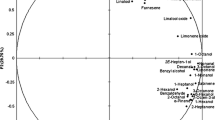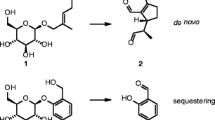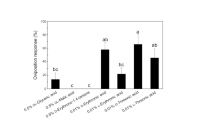Abstract
European grapevine moth females (Lobesia botrana, Lepidoptera Tortricidae) select an oviposition site by tasting the host plant surface and then gluing a single egg on berries from grapes or from several other host plant species. In doing so, females should avoid ovipositing on plants that are detrimental to their progeny. Do they sense the same deterrent compounds as larvae, despite the fact that they do not have access to the same compartments of the plants? We tested this hypothesis with 20-hydroxyecdysone (20E), purified from Leuzea carthamoides. Phytoecdysteroids are usually found inside plant tissues and accessible to larvae in an aqueous phase, while adults would access them only through the epicuticular wax. We first confirmed that larvae avoid feeding on 20E and that they taste 20E with their lateral sensilla styloconica, at a threshold of 10−6 M. Then, we tested whether adult females avoid ovipositing on glass spheres sprayed with 20E. When given a choice, females avoided laying eggs on a treated surface, at a threshold of 8 ng/cm2. In addition, they deposited significantly fewer eggs in the presence of 20E. Presuming that legs play an important role in assessing the oviposition substrate, we assessed the sensitivity of their taste receptors. In females, 14 taste sensilla are located on the ventral side of the last tarsus of the prothoracic leg. One group of these sensilla house one neuron that is sensitive to 20E, with a detection threshold of about 10−7 M. The same molecule is thus sensed both in larvae and adults of L. botrana where it respectively inhibits feeding and oviposition.








Similar content being viewed by others
References
Akhtar, Y. and Isman, M. B. 2003. Larval exposure to oviposition deterrents alters subsequent oviposition behavior in generalist, Trichoplusia ni and specialist, Plutella xylostella moths. J. Chem. Ecol. 29:1853–1870.
Blackford, M. and Dinan, L. 1997a. The effects of ingested ecdysteroid agonists (20-hydroxyecdysone, RH5849 and RH5992) and an ecdysteroid antagonist (cucurbitacin B) on larval development of two polyphagous lepidopterans (Acherontia atropos and Lacanobia oleracea). Entomol. Exp. Appl. 83:263–276.
Blackford, M. and Dinan, L. 1997b. The tomato moth Lacanobia oleracea (Lepidoptera, Noctuidae) detoxifies ingested 20-hydroxyecdysone, but is susceptible to the ecdysteroid agonists RH-5849 and RH-5992. Insect Biochem. Mol. Biol. 27:167–177.
Blackford, M. J. P. and Dinan, L. 1997c. The effects of ingested 20-hydroxyecdysone on the larvae of Aglais urticae, Inachis io, Cynthia cardui (Lepidoptera, Nymphalidae) and Tyria jacobaeae (Lepidoptera, Arctiidae). J. Insect Physiol. 43:315–327.
Blackford, M., Clarke, B., and Dinan, L. 1996. Tolerance of the Egyptian cotton leafworm Spodoptera littoralis (Lepidoptera, Noctuidae) to ingested phytoecdysteroids. J. Insect Physiol. 42:931–936.
Blackford, M. J. P., Clarke, B. S., and Dinan, L. 1997. Distribution and metabolism of exogenous ecdysteroids in the Egyptian cotton leafworm Spodoptera littoralis (Lepidoptera, Noctuidae). Arch. Insect Biochem. Physiol. 34:329–346.
Bovey, P. 1966. Super-famille des Tortricoidea, pp. 456–893, in A. S. Balachoswky (ed.). Entomologie appliquée à l’agriculture, Tome II, Lépidoptères. Masson, Paris.
Descoins, C. and Marion-Poll, F. 1999. Electrophysiological responses of gustatory sensilla of Mamestra brassicae (Lepidoptera, Noctuidae) larvae to three ecdysteroids: ecdysone, 20-hydroxyecdysone and ponasterone A. J. Insect Physiol. 45:871–876.
Dinan, L. 1998. A strategy towards the elucidation of the contribution made by phytoecdysteroids to the deterrence of invertebrate predators on plants. Russ. J. Plant Physiol. 45:296–305.
Dinan, L., Savchenko, T., and Whiting, P. 2001. On the distribution of phytoecdysteroids in plants. Cell. Mol. Life Sci. 58:1121–1132.
Inoshita, T. and Tanimura, T. 2006. Cellular identification of water gustatory receptor neurons and their central projection pattern in Drosophila. PNAS 103:1094–1099.
Kubo, I., Klocke, J. A., and Asano, S. 1983. Effects of ingested phytoecdysteroids on the growth and development of two lepidopterous larvae. J. Insect Physiol. 29:307–316.
Ma, W.-C. 1969. Some properties of gustation in the larvae of Pieris brassicae. Entomol. Exp. Appl. 12:584–590.
Maher, N. 2002. Oviposition site selection by Lobesia botrana (Lepidoptera: Tortricidae): influence of non-volatile chemical cues from host plants fruits [Doctorat de l’Université Bordeaux 2]: Université Victor Segalen Bordeaux 2. 109 pp.
Maher, N. and Thiéry, D. 2004a. A bioassay to evaluate the activity of chemical stimuli from grape berries on the oviposition of Lobesia botrana (Lepidoptera: Tortricidae). Bull. Entomol. Res. 94:27–33.
Maher, N. and Thiéry, D. 2004b. Distribution of chemo- and mechanoreceptors on the tarsi and ovipositor of female European grapevine moth, Lobesia botrana. Entomol. Exp. Appl. 110:135–143.
Maher, N. and Thiéry, D. 2006. Daphne gnidium, a possible native host plant of the European grapine moth Lobesia botrana, stimulates its oviposition. Is a host shift relevant? Chemoecology 16:135–144.
Maher, N., Jolivet, M., and Thiéry, D. 2001. Preference of the European grapevine moth, Lobesia botrana (Lepidoptera, Tortricidae) between different types of vine: influence of chemical information on the surface of berries. Bull. OILB/SROP 24:103–107.
Maher, N., Thiery, D., and Stadler, E. 2006. Oviposition by Lobesia botrana is stimulated by sugars detected by contact chemoreceptors. Physiol. Entomol. 31:14–22.
Marion-Poll, F. 1996. Display and analysis of electrophysiological data under Windows. Entomol. Exp. Appl. 80:116–119.
Marion-Poll, F. and Descoins, C. 2002. Taste detection of phytoecdysteroids in larvae of Bombyx mori, Spodoptera littoralis and Ostrinia nubilalis. J. Insect Physiol. 48:467–476.
Marion-Poll, F. and Van Der Pers, J. N. C. 1996. Un-filtered recordings from insect taste sensilla. Entomol. Exp. Appl. 80:113–115.
Marion-Poll, F., Guillaumin, D., and Masson, C. 1992. Sexual dimorphism of tarsal receptors and sensory equipment of the ovipositor in the European corn borer, Ostrinia nubilalis. Cell Tissue Res. 267:507–518.
Meunier, N., Marion-Poll, F., Rospars, J. P., and Tanimura, T. 2003. Peripheral coding of bitter taste in Drosophila. J. Neurobiol. 56:139–152.
Mondy, N., Caissa, C., Pitoizet, N., Delbecque, J. P., and Corio-Costet, M. F. 1997. Effects of the ingestion of Serratula tinctoria extracts, a plant containing phytoecdysteroids, on the development of the vineyard pest Lobesia botrana (Lepidoptera, Tortricidae). Arch. Insect Biochem. Physiol. 35:227–235.
Mondy, N., Ustache, K., Darazy-Choubaya, D., Marion-Poll, F., and Corio-Costet, M.-F. 1999. Effets de l’ingestion de Serratula tinctoria sur Lobesia botrana (Denis et Schiffer-Müller): développement et réponses gustatives. Ann. Soc. Entomol. Fr. 35:517–520.
Schoonhoven, L. M. and Derksen-Koeppers, I. 1973. Effects of secondary plant substances on drinking behavior in some Heteroptera. Entomol. Exp. Appl. 16:141–145.
Tanaka, Y. and Takeda, S. 1993. Ecdysone and 20-hydroxyecdysone supplements to the diet affect larval development in the silkworm, Bombyx mori, differently. J. Insect Physiol. 39:805–809.
Tanaka, Y., Asaoka, K., and Takeda, S. 1994. Different feeding and gustatory responses to ecdysone and 20-hydroxyecdysone by larvae of the silkworm, Bombyx mori. J. Chem. Ecol. 20:125–133.
Thiéry, D. 2005. Vers de la grappe, les connaître pour s’en protéger. Guide Pratique, Vigne & Vins Publ. Int., Bordeaux, France.
Thiéry, D. and Gabel, B. 2000. Oviposition behaviour of females of the European grapevine moth Lobesia botrana in the presence of flower extracts of ‘Muller Thurgau.’ Bull. OILB/SROP 23:135–138.
Thiéry, D. and Moreau, J. 2005. Relative performance of European grapevine moth (Lobesia botrana) on grapes and other hosts. Oecologia 143:548–557.
Torres-Vila, L. M., Stockel, J., Roehrich, R., and Rodriguez-Molina, M. C. 1997. The relation between dispersal and survival of Lobesia botrana larvae and their density in vine inflorescences. Entomol. Exp. Appl. 84:109–114.
Acknowledgements
We thank René Lafont (University Paris VI) for his gift of 20E and many scientific discussions. We also thank Andrée Berthier for excellent technical assistance and Claire Barthe who contributed to behavioral experiments on adults. This work was supported by an INCO-DEV program SUSVEG-ASIA, and by the Comité Interprofessionnel des Vins de Bordeaux.
Author information
Authors and Affiliations
Corresponding authors
Rights and permissions
About this article
Cite this article
Calas, D., Thiéry, D. & Marion-Poll, F. 20-Hydroxyecdysone Deters Oviposition and Larval Feeding in the European Grapevine Moth, Lobesia botrana . J Chem Ecol 32, 2443–2454 (2006). https://doi.org/10.1007/s10886-006-9155-3
Published:
Issue Date:
DOI: https://doi.org/10.1007/s10886-006-9155-3




